Answered step by step
Verified Expert Solution
Question
1 Approved Answer
previous codes: def get_largest_value(dictionary): value1 = 0 for value in dictionary.values(): if value > value1: value1 = value return value1 def ordered_keys(dict1, ordering = 'key',

previous codes:
def get_largest_value(dictionary): value1 = 0 for value in dictionary.values(): if value > value1: value1 = value return value1
def ordered_keys(dict1, ordering = 'key', ascending = True): if ordering == 'key': keys = list(dict1) if ascending == True: return sorted(keys) else: return sorted(keys, reverse=True) else: values = list(dict1.values()) if ascending == True: return sorted(dict1, key=dict1.__getitem__) else: return sorted(dict1, key=dict1.__getitem__, reverse=True)
You are provided with the function header: def generate histogram 04Cdata, max_bar length - 10, ordering-'key', ascending-True): Use the ordering function you defined previously to complete the function so the histogram can be ordered in different ways. osou get_largest_value ordered_keys For example: Test Result data 'a'1, 'b':5, 'c'3 generate_histogram_04(data) a XX data f'a 10, 'b : 50, C:30 generate_histogram_04(data, ascending-False, ordering-'value cXXXxxx a XxStep by Step Solution
There are 3 Steps involved in it
Step: 1

Get Instant Access to Expert-Tailored Solutions
See step-by-step solutions with expert insights and AI powered tools for academic success
Step: 2

Step: 3

Ace Your Homework with AI
Get the answers you need in no time with our AI-driven, step-by-step assistance
Get Started


